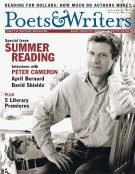And regardless of the structural decisions the essayist arrives at, there is another caution: The essay cannot simply become an exercise in narcissism. "It's not fundamentally about the essayist," says Sanders. "The essay speaks about how the mind and the heart of the essayist intersect with something much larger than the essayist."
Rodriguez agrees. "For me, there's a rigor to the essay," he says. "I require that the essay I write in some sense be about experiences or ideas that other people are proposing or arguing about. It cannot simply be about my experience."
Still, the essay's beating heart is the writer him- or herself, the story (or stories) subordinate to what the individual is making of it (or them). "I find that the reliance the reader puts upon an essay is a reliance that I seem to bear rather directly," says Pulitzer Prize–winning novelist Richard Ford. "They want an inquiring intelligence seen to be at work, leading to some distillation or expression of intelligence derived from real-life experience."
But ironically, this desire for intelligence and insight from the essay, with its critical and analytical tendencies, may have put it in lower standing than other literary forms. "In the early twentieth century, the essay was used to explain works of modernism, and it became a great critical tool," Atwan says. "It was used to explain poetry, drama, and fiction, and as a result of that it wasn't considered a literary form itself."
By the 1960s, he says, it had become a kind of endangered literary species, relegated to the lesser tier of journalism and commentary. Putting the essay in critical service to other forms had diminished its own standing, making for a largely absent body of critical theory and vocabulary on the form itself.
And then, a strange twist. As the essay dwindled away in print, exiled to a few literary publications, it began to emerge from unexpected sources. National Public Radio began broadcasting essays on its daily news programs, a practice that can be seen as having led to present-day weekly shows like Public Radio International's This American Life. Television introduced its own forays, from Andy Rooney's pieces on CBS's 60 Minutes to essays by Rodriguez on PBS's The NewsHour With Jim Lehrer. Essays began to abound on the Internet in online magazines like Slate and Salon, introducing hypertextuality to the form and vastly broadening its readership.
This revitalization was coupled in the 1990s with the public's growing interest in memoir, the essay's closest literary cousin. Readers' hunger for self-disclosure became nearly insatiable, and readers made genuine stars out of writers like David Sedaris, a humorist-essayist who first gained popularity on NPR, went on to publish collections of his personal musings, and now routinely sells out large theaters for his readings, evoking a widespread popularity of the form not seen since the days of Mark Twain. Suddenly, it was not inconceivable for the essayist to become a rock star.
Rodriguez says his own work, as presented in his appearances on television, introduced a counterpoint to the news that has struck a chord with viewers. "There was some desire to end the official discussion of the day's news with a human voice that was simply mulling it over," he says. "It was a reminder that all this news will play against a consciousness."
But what radio, television, and the Internet lent the form in popularity, even poignancy, they threatened in the essay's potency. Ford, who has written numerous essays for radio, says the medium's limitations are considerable. "The thoroughness that the mind is capable of is foreshortened," he says. "References and second thoughts are foreshortened. Pithiness is rewarded about a subject for which pithiness is not usually a virtue."
Sanders says the Internet's hypertextual nature, too, can have an adverse effect on essay writing. "It will tempt writers to write in more fractured, more fragmented ways, because that's the way most information comes to us now," he says.
Oates agrees. "The qualities that we see on the Internet are brevity and succinctness, and maybe a little bit of flippancy and shallowness," she says. "So you don't quite come away with as much depth on the Internet."
Still, however mutable other media may have made it, the essay has heartily rebounded from the endangered-species list. Anthologies, including the Best American Essays series, are flourishing, and essays continue to find a regular home in periodicals ranging from The New Yorker and Harper's to Boulevard, the Yale Review, the Gettysburg Review, and the Georgia Review.
But if the essay has found itself on more solid footing than it was 50 years ago, if the word itself enjoys greater literary standing ("The term no longer has the negative resonance that it did when I started the series," Atwan says), there is still the matter of its shimmering, protoplasmic borders. When does the mere "essayistic" begin to walk securely on the terra firma of the essay? Where does the essay begin to strain under the devices of other forms—the lengthy, unmediated divulgence of the memoir, the multiple points of authority of journalism, the evaluative checklist of the review? When will it offer us the structural assurances of the poem, the short story, the novel?
Perhaps it is the essay's very nature to deny us such certainty. For there just might not be an actual territory of the essay, but only the trying to find it.
Michael Depp is the Reuters correspondent for Louisiana. He contributes to numerous periodicals and to The Dictionary of Literary Biography (Gale). He lives in New Orleans.









